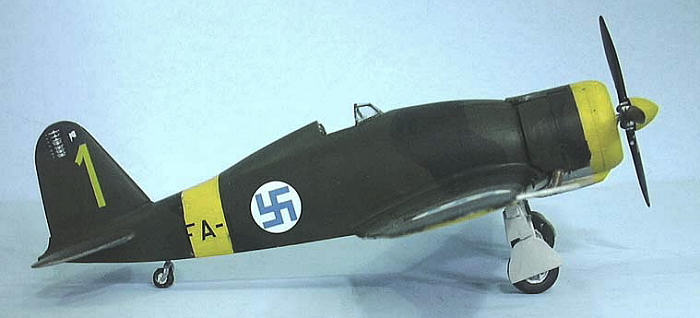
| KIT #: | 48086 |
| PRICE: | 5850 yen at www.hlj.com |
| DECALS: | Four options |
| REVIEWER: | Tom Cleaver |
| NOTES: | Short run with resin |

| HISTORY |
The G.50
Freccia (Arrow), the first all-metal monoplane fighter to
see service with the Regia Aeronautica,
was designed by Giuseppe Gabrielli.
The first prototype flew
February 26, 1937. The G.50 was the first Italian
fighter with retractable undercarriage, but its maximum speed was only 33 km/h
faster than the C.R.42.
Both were powered by the 840 hp Fiat A.74 RC38,
14-cylinder, air-cooled radial engine, which was at least a generation behind
the powerplants in use by the air forces of the major powers.
The initial production order was
for 40 G.50s, of which 12 were sent to Spain in 1938 for testing under operating
conditions with the Gruppo Caccia Sperimentale
(Experimental Fighter Group). The G.50 proved to be one of the fastest and most
maneuverable fighters used during the Spanish Civil War, with the result that a
further 200 were ordered.
As a result of operational
experience, the enclosed cockpit canopy was deleted, due to the dislike on the
part of pilots. A two seater trainer was built and designated G.50B, with the
first one flown April 30, 1940, followed by 100 more. The G.50bis flew September
9, 1940, and was distinguished from the G.50 by a shorter vertical fin and
rudder and a fuselage lengthened by 10 inches.
A total of 250 G.50 and 450 G.50bis fighters were
ordered before production was ended in 1942, of which at least 780 were actually
produced.
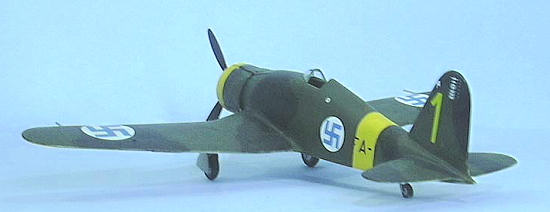 When Italy entered the Second World
War on June 10, 1940, 48 G.50s of the 20th Gruppo Caccia Terrestre were part of
the
Corpo Aero Italiano sent by the Regia Aeronautica
to Ursel, Belgium in October of 1940 for operations in the Battle of Britain.
The G.50s did not participate in any of the limited missions flown over Britain
before the retirement of the Italian force.
In early 1941,
when the Italians attempted to invade Greece, the Regia
Aeronautica received a rude shock when the G.50 units
finally encountered modern fighters in the form of RAF Hurricanes, and
discovered that their mount was seriously underpowered and underarmed.
450 G.50bis fighter were produced, 10 of which were
supplied to the Croatian Air Force.
While the airplane was universally condemned as
underpowered, all pilots commended its finger-light controls and
maneuverability.
When Italy entered the Second World
War on June 10, 1940, 48 G.50s of the 20th Gruppo Caccia Terrestre were part of
the
Corpo Aero Italiano sent by the Regia Aeronautica
to Ursel, Belgium in October of 1940 for operations in the Battle of Britain.
The G.50s did not participate in any of the limited missions flown over Britain
before the retirement of the Italian force.
In early 1941,
when the Italians attempted to invade Greece, the Regia
Aeronautica received a rude shock when the G.50 units
finally encountered modern fighters in the form of RAF Hurricanes, and
discovered that their mount was seriously underpowered and underarmed.
450 G.50bis fighter were produced, 10 of which were
supplied to the Croatian Air Force.
While the airplane was universally condemned as
underpowered, all pilots commended its finger-light controls and
maneuverability.
In November 1939, Finland purchased
35 Fiat G.50s from Italy, these being serialed FA-1 to FA-35. It was completely
ironic that the Italians - whose invasion of Ethiopia in 1935 had demonstrated
the inability of the League of Nations to deal effectively with international
aggression - would take a position in support of the League in its final
international effort; of course, the fact it was aimed at the Soviet Union was
the reason why so many countries that were fighting each other elsewhere, such
as France and Great Britain and Germany, would cooperate on this issue.
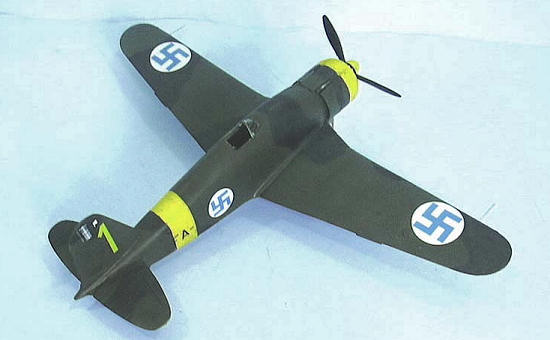 Only 14 of the 30 G.50s that were
delivered before the end of the Winter War in March 1940 were in operational
condition. These aircraft were assigned to three flights of
Lentolaivue 26 and replaced the unit’s Fokker XXIs and
Gloster Gladiators. 13 aerial victories were gained in the short time they were
operational before the armistice.
Captain O. Ehrnrooth, Lt. O. Puhakka and Sgt. L.
Aaltonen were the most successful with 2 victories each.
Only 14 of the 30 G.50s that were
delivered before the end of the Winter War in March 1940 were in operational
condition. These aircraft were assigned to three flights of
Lentolaivue 26 and replaced the unit’s Fokker XXIs and
Gloster Gladiators. 13 aerial victories were gained in the short time they were
operational before the armistice.
Captain O. Ehrnrooth, Lt. O. Puhakka and Sgt. L.
Aaltonen were the most successful with 2 victories each.
The remaining five G.50s were
delivered in April 1940, and all aircraft were serviceable by the time of the
outbreak of the Continuation War in June 1941.
During the Continuation War, the
G.50s operated by LeLv26 saw their
greatest
success during the attack phase of 1941, when they scored 52 victories
for the loss of two G.50s.
Unfortunately, the arrival of better and newer Soviet
types on the Northern Front during 1942-43, coupled with the lack of spares for
the G.50s, resulted in reduced operations. The most successful pilots were O.
Tuominen with 23 victories, O. Puhakka with 11, N. Trontti with 6, with O.
Paronen, U. Nieminen and L. Lautamäki each scoring 4. Throughout their service,
LeLv 26 scored 99 aerial victories with
the Fiat G.50 for a loss of 4 in combat.
The Finnish Fiats were finally phased out of front line operational service in the summer of 1944, shortly before the Finnish surrender. (Editor's Note: it has been pointed out to me by several readers that Finland did not surrender but signed an Armistice with the Soviets that provided some concessions, both in terms of territory and materiel, but left Finland independent.)
| THE KIT |
Special Hobby’s 1/48 Fiat G.50 is
the second kit of this airplane in this scale, the first coming from Secter
about 16 years ago, but being better-known in its release by Hasegawa following
the demise of Secter, and now released by Pacific Coast Models
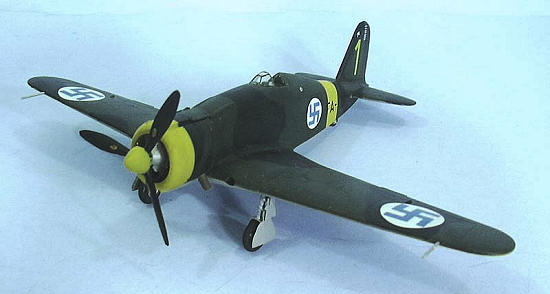 with
additional resin parts for a fully-detailed cockpit.
with
additional resin parts for a fully-detailed cockpit.
The Special Hobby kit is not as
detailed as the PCM release of the old Secter kit, but it is better as regards
surface detail.
Additionally, the Special Hobby kit provides parts to make either
the G.50 or the G.50bis, as well as the G.50bis A.S. tropical version used in
North Africa.
The cowling is a one-piece resin part, with a resin engine that
comes with separate cylinders.
The cockpit is nowhere near as detailed as the resin
cockpit in the PCM kit but it looks acceptable if one does not lower the side
flaps.
Both the early, taller, vertical fin and rudder and the shorter,
broader, later fin and rudder are provided in injection plastic.
Decals in this version are provided for four different G.50s in Finnish Service, including multiple markings for three different airplanes at different stages of their service.
| CONSTRUCTION |
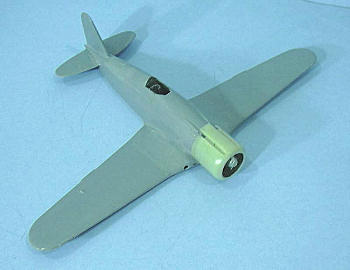 Construction is simple.
I assembled the cockpit and determined after looking at
it that I would keep the side flaps up, which look better anyway.
Construction is simple.
I assembled the cockpit and determined after looking at
it that I would keep the side flaps up, which look better anyway.
The upper part of the fuselage
doesn’t fit very well, but it succumbed to a coat of cyanoacrylate glue to fill
the seam and then a thick coat of Mr. Surfacer to cover it.
I also needed Mr. Surfacer for the centerline of the
fuselage and the upper join of the wing to the fuselage for gap-filling.
Once this was dry, I sanded it smooth and rescribed
panel detail as necessary.
| COLORS & MARKINGS |
Painting:
The kit painting instructions
indicate that these airplanes were only repainted on their upper surfaces, with
the lower surfaces remaining in Italian light grey.
After applying Tamiya “Flat Yellow” and masking it
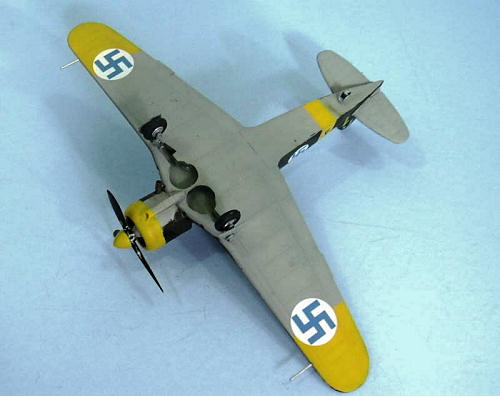 off, I
painted the lower surfaces with Tamiya “sky Grey” and the upper surfaces with
Tamiya “Olive Green” and “Flat Black.”
When all was dry, I unmasked the model and gave it a
coat of Future.
off, I
painted the lower surfaces with Tamiya “sky Grey” and the upper surfaces with
Tamiya “Olive Green” and “Flat Black.”
When all was dry, I unmasked the model and gave it a
coat of Future.
Decals:
I used Finnish insignia from the
decal dungeon, since I didn’t want to deal with the multi-part decals provided
to get around the European prohibitions on display of the swastika.
The kit decals were used to portray FA-1 as it was seen
in the summer of 1942, following its repaint from Italian to Finnish camouflage.
| FINAL CONSTRUCTION |
I gave the model a coat of
Xtracrylix Flat Varnish with a brushful of Tamiya “Flat Base” to get rid of the
slight sheen I get with Xtracrylix done “straight.”
I then attached the landing gear
and prop, and the cockpit windscreen.
| CONCLUSIONS |

Review Kit courtesy of
HobbyLink Japan.
If you would like your product reviewed fairly and quickly, please contact me or see other details in the Note to Contributors.